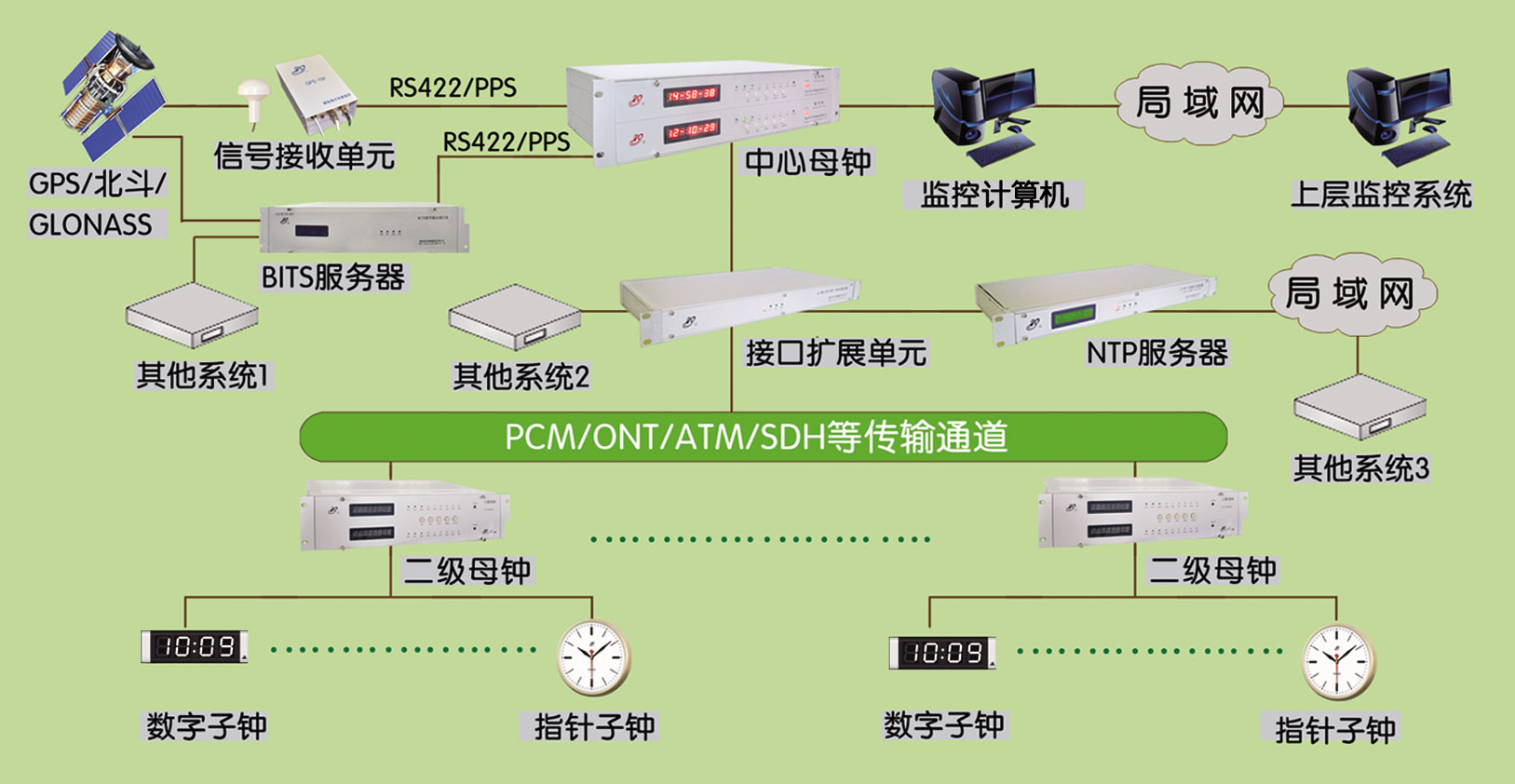Rail Transit Time System Solutions

Basic Features
The central master clock receives the standard time signal from GPS/Beidou/GLONASS, transmits it to each secondary master clock and slave clock through the interface expansion unit, and provides it to other users by the NTP server, BITS server and interface expansion unit to realize the time of the whole system Synchronize. At the same time, the state monitoring of the whole system is realized through the monitoring computer, and the state information can be provided to the upper-level monitoring system.
Key Features
The system applies the world's advanced information technology, absorbs the concept of industrial control, follows the principle of equal emphasis on advancement and practicability, considers scalability and compatibility, and innovates heterogeneous network clock synchronization, adaptive compensation, time base denoising, and clock synchronization. Key technologies such as security, redundant backup, network online real-time monitoring, network fault diagnosis, and remote automatic alarm have realized the high accuracy, high reliability and safety of the large-area time synchronization system. At the same time, the appearance design of the equipment and the decoration style of the site are coordinated with each other to achieve the perfect combination of function and appearance.
Technical parameters
The system adopts a three-layer structure of a central master clock, a secondary master clock, and a slave clock, which is suitable for various transmission formats such as PCM, ONT, ATM, and SDH. The accuracy, reliability and security of the regional clock synchronization system make the clock synchronization technology lead the international level. The system is mainly used for clock synchronization in large areas, such as large-scale comprehensive projects such as rail transit, high-speed railway, hub airport, and nuclear power plant.
System Parameters
| 1) System Architecture: | Three layers |
2) Communication protocol: | PCM, ONT, ATM, SDH, NTP protocol, dedicated RS422/485 and 2MHz/2Mbit |
3) Communication distance: | ≤120 sets |
4) Number of secondary master clocks: | equivalent to transport system |
5) System standard configuration: | The number of sub-clocks and digital sub-clocks can be 4200 faces |
| 6) System synchronization error: | Sub clock≤10ms, NTP server≤2ms, BITS server≤20ns |
Device parameters
| GPS/Beidou/GLONASS Signal Receiving Unit | |
| 1) Operating temperature: | -30℃~+65℃ |
2) Relative Humidity: | ≤95% |
3) Frequency stability: | 10-12~10-9 |
4) Sync Error: | GPS≤50ns, Beidou≤100ns, GLONASS≤30ns |
5) Signal transmission distance: | ≤1200m |
6) Interface: | Standard RS422/485 |
7) Antenna feeder length: | 5~100m (standard 30m) |
8) Power supply: | AC220V±15% 50Hz±5% |
| 9) Power consumption: | ≤20W |
| 10) MTBF: | ≥85,000 hours |
| 11) Antenna: | With dustproof, waterproof, anti-corrosion, lightning protection |
Secondary Master Clock | |
1) Self-timer precision: | ±0.01s/d |
2) Working temperature: | -10℃~+65℃ |
3) Relative Humidity: | ≤95% |
4) Interface: | Standard RS422/RS485/RS232/NTP |
5) Number of standard output ports: | 2 |
6) The number of sub-clocks that can be built: | ≤320 sides |
7) Power: | AC220V±15% 50Hz±5% |
8) Power consumption: | ≤20W |
| 9) MTBF: | ≥85,000 hours |
| NTP server | |
| 1) Operating temperature: | -10℃~+65℃ |
| 2) Relative Humidity: | ≤95% |
| 3) Sync Error: | ≤2ms |
| 4) Output interface: | 10BaseT/100BaseT Ethernet interface |
| 5) Number of output ports: | 1 to 4 |
| 6) Client capacity: | 8000 times/sec |
| 7) Protocol: | SNTP/NTP V2,V3,V4, etc. |
| 8) Management port: | remote management via ethernet interface |
| 9) Power supply: | AC220V±15% 50Hz±5% |
| 10) Power consumption: | ≤10W |
Analog Clock | |
1) Self-precision: | ±0.05s/d |
2) Output torque: | 800~1200g. cm |
3) Working temperature: | -35℃~+70℃ |
4) Relative Humidity: | ≤95% |
5) Working voltage: | AC220V±15% 50Hz±5% |
| 6) MTBF: | ≥85,000 hours |
Digital Clock | |
| 1) Self-precision: | ±0.05s/d |
| 2) Working temperature: | -35℃~+70℃ |
| 3) Relative Humidity: | ≤95% |
| 4) Working voltage: | AC220V±15% 50Hz±5% |
| 5) LED luminous intensity: | ≥1000mcd |
| 6) MTBF: | ≥85,000 hours |
